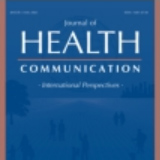
Preface written by Scott Razan.
For nearly two decades we have been publishing hundreds of articles heralding the promise, impact, and value of communication in advancing the health of people globally. There has been unprecedented growth in the discipline, not only among academia and researchers, but in the field where practitioners hope to apply the ideal approach for advancing health at the individual and population level. Globally, multilateral institutions, donor agencies, and private sector and civil society also seek to advance health and well-being with sustainable social and behavioral change.
With that in mind, this issue of the Journal of Health Communication on Population-Level Behavior Change to Enhance Child Survival and Development in Low- and Middle-Income Countries: A Review of the Evidence, edited by Elizabeth Fox and Robert L. Balster, addresses the challenges of finding and using the best evidence in health programs facing the global health community.
As the world recommitted to addressing child mortality with Promise Renewed in 2012 concomitant with the ongoing interest in progressing the Millennium Development Goals (MDGs) that relate to women’s and children’s health by the 2015 deadline, the Evidence Summit and articles in this issue offer the state of the evidence on a variety of areas. While I (the editor-in-chief of Journal of Health Communication) had the opportunity to chair the Science, Innovation, and Technology Evidence Review team, it became clear that an Evidence Summit and publication of results of our “knowledge” were necessary to help progress “evidence to practice” at scale.
Heretofore many have cited individual articles in prior issues of this journal as well as the systematic review of communication interventions in health, including child survival from 1998 through 2009 in the Lancet conducted by Wakefield, Loken, and Hornik (2010); we are fortunate to publish an updated review on the effectiveness of mass media interventions by Naugle and Hornik in this issue.
Finally, in the course of my editorship and academic work, I am pleased to have witnessed the growth and unprecedented reach with basic to advanced communication technologies on population-level behavior change. The challenges are still great in how to engage multiple actors, including those in the public and private sectors, to maximize impact with evidence-based approaches that require resources, competencies, and synergies.
All of these articles document the evidence-based approaches for social and behavior change that should offer support for global health leaders along with policymakers and practitioners at country and regional levels to invest in our future and advance child health and development. To this end, I congratulate the editors and the authors in this supplement for their contribution to global health and hope that together, we can all advance a better world.
Editorial:
- E. Foxa, R. Obregón. Population-Level Behavior Change to Enhance Child Survival and Development in Low- and Middle-Income Countries
- S. Waisbord. Where Do We Go Next? Behavioral and Social Change for Child Survival
Browse the Articles Below:
- R. Balstera, S. Levy E. Stammer. Evidence Acquisition and Evaluation for Evidence Summit on Population-Level Behavior Change to Enhance Child Survival and Development in Low- and Middle-Income Countries
- J. Eldera, W. Pequegnat, S. Ahmed, et al. Caregiver Behavior Change for Child Survival and Development in Low- and Middle-Income Countries: An Examination of the Evidence
- S. Farnswortha, K. Böseb, O. Fajobib, et al. Community Engagement to Enhance Child Survival and Early Development in Low- and Middle-Income Countries: An Evidence Review
- L. Véleza, M. Sanitatob, D. Barry,et al. The Role of Health Systems and Policy in Producing Behavior and Social Change to Enhance Child Survival and Development in Low- and Middle-Income Countries: An Examination of the Evidence
- J. Kraft, K. Wilkins, G.Morales, et al. An Evidence Review of Gender-Integrated Interventions in Reproductive and Maternal-Child Health
- U. Nayara, A. Stangl, B. De Zalduondo, et al. Reducing Stigma and Discrimination to Improve Child Health and Survival in Low- and Middle-Income Countries: Promising Approaches and Implications for Future Research
- E. Higgsa, A. Goldberg, A. Labrique, et al. Understanding the Role of mHealth and Other Media Interventions for Behavior Change to Enhance Child Survival and Development in Low- and Middle-Income Countries: An Evidence Review
Commissioned Review Article:
- D. Nauglea, R. Hornika, et al. Systematic Review of the Effectiveness of Mass Media Interventions for Child Survival in Low- and Middle-Income Countries